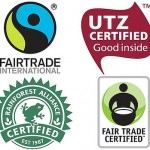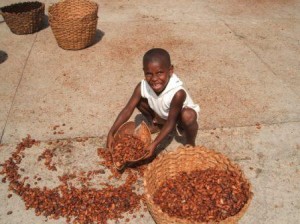Keeping Your Chocolate Slave-Free
TRANSCEND MEMBERS, 17 Feb 2014
Marianne Perez – TRANSCEND Media Service
 With a product as good as chocolate, it’s hard to imagine that it can have a part in modern day slavery. But the good news is that there is an industry-wide response to tackle the issue.
With a product as good as chocolate, it’s hard to imagine that it can have a part in modern day slavery. But the good news is that there is an industry-wide response to tackle the issue.
With over 58 million pounds (26 million kilograms) of chocolate consumed each year during Valentine’s week, about 5% of the annual total consumption, this is the time to think about where your chocolate comes from… and at what price. The main ingredients in chocolate are cocoa butter and cocoa powder are both derived from cocoa beans. While we tend to think of chocolate coming from the northern hemisphere (luxury chocolates from Switzerland and Austria while the industrial chocolate powerhouses are in the US, France and Belgium), the raw materials come from countries close to the equator. Ivory Coast produces 70% of the world’s cocoa beans. Unfortunately, in Ivory Coast and in other cocoa producing countries, much of the cacao is harvested by slave labor, including children, who work up to 16 hours a day for no pay.
While slavery is a global problem that spans all countries and industries, in 2012 UNICEF estimated that nearly a half-million children work on cacao farms across Ivory Coast. That’s 500,000 child slaves in Ivory Coast in cacao cultivation alone! Conservative estimates put the total number of people enslaved around the world today at 21 to 30 million people (26% of which are children)!
So what can be done? In 2001, US Congressional staffers designed the Cocoa Protocol which brought together all the major chocolate companies, labor unions, consumer groups, anti-child labor and anti-slavery groups to abolish slavery in the chocolate industry. Components of the protocol include researching the size of the slavery problem, setting up a foundation to remove slavery from the chocolate industry and creating a certification process to evaluate progress and help consumers identify slave-free products. By bringing together stakeholders all along the chocolate production value chain, this initiative has a chance of succeeding because the problem is being tackled holistically.
“It may sound strange but there is profit in ending slavery. When you set millions of people free to work for themselves, to buy food and clothing and shelter and education and medicine and even toys for their children, you unchain productivity. The result is a freedom dividend of significant proportions,” says Kevin Bales – Co-Founder and President of Free the Slaves.
 In the meantime, this Valentine’s Day and whenever you buy chocolate, be sure to look for products that are certified Fair Trade or sustainable. You can also use guides like the Ethical Consumer’s chocolate guide to find the right chocolate for you. And if you want to take it a step further, you can raise awareness in your community by participating in campaigns like Global Exchange’s Sweet Smarts. What’s your favorite slave-free chocolate?
In the meantime, this Valentine’s Day and whenever you buy chocolate, be sure to look for products that are certified Fair Trade or sustainable. You can also use guides like the Ethical Consumer’s chocolate guide to find the right chocolate for you. And if you want to take it a step further, you can raise awareness in your community by participating in campaigns like Global Exchange’s Sweet Smarts. What’s your favorite slave-free chocolate?
Go to Original – peaceissexy.net
DISCLAIMER: The statements, views and opinions expressed in pieces republished here are solely those of the authors and do not necessarily represent those of TMS. In accordance with title 17 U.S.C. section 107, this material is distributed without profit to those who have expressed a prior interest in receiving the included information for research and educational purposes. TMS has no affiliation whatsoever with the originator of this article nor is TMS endorsed or sponsored by the originator. “GO TO ORIGINAL” links are provided as a convenience to our readers and allow for verification of authenticity. However, as originating pages are often updated by their originating host sites, the versions posted may not match the versions our readers view when clicking the “GO TO ORIGINAL” links. This site contains copyrighted material the use of which has not always been specifically authorized by the copyright owner. We are making such material available in our efforts to advance understanding of environmental, political, human rights, economic, democracy, scientific, and social justice issues, etc. We believe this constitutes a ‘fair use’ of any such copyrighted material as provided for in section 107 of the US Copyright Law. In accordance with Title 17 U.S.C. Section 107, the material on this site is distributed without profit to those who have expressed a prior interest in receiving the included information for research and educational purposes. For more information go to: http://www.law.cornell.edu/uscode/17/107.shtml. If you wish to use copyrighted material from this site for purposes of your own that go beyond ‘fair use’, you must obtain permission from the copyright owner.
